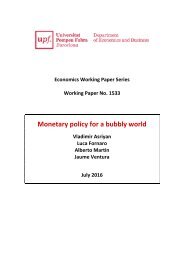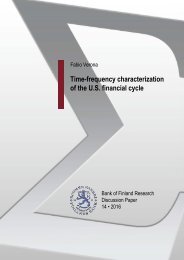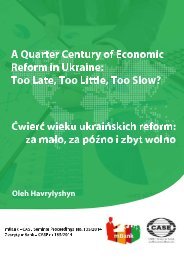Necessity as the mother of invention monetary policy after the crisis
n?u=RePEc:dnb:dnbwpp:525&r=mac
n?u=RePEc:dnb:dnbwpp:525&r=mac
You also want an ePaper? Increase the reach of your titles
YUMPU automatically turns print PDFs into web optimized ePapers that Google loves.
egulatory limits on leverage and short-term funding, <strong>as</strong> well <strong>as</strong> stronger underwriting<br />
standards, represent far more direct and likely more effective methods to address <strong>the</strong>se<br />
vulnerabilities” than <strong>monetary</strong> <strong>policy</strong>. 12 In o<strong>the</strong>r words, yes, we’re ultimately responsible<br />
for financial stability, but not by using <strong>monetary</strong> <strong>policy</strong>.<br />
Our survey results (displayed in Table 3 below) show that almost 80% <strong>of</strong> governors<br />
report that <strong>the</strong>ir institution used some form <strong>of</strong> macro-prudential <strong>policy</strong> in recent years.<br />
What are <strong>the</strong>se “o<strong>the</strong>r” (than interest rates) macro-prudential instruments? Figure 4 shows<br />
<strong>the</strong> five instruments that were most actively used in 2013, according to <strong>the</strong> datab<strong>as</strong>e <strong>of</strong><br />
Cerutti et al. (2015).<br />
80%<br />
60%<br />
40%<br />
20%<br />
0%<br />
Loan-to-Value<br />
Ratio Caps<br />
Debt-to-Income<br />
Ratio<br />
Limits on<br />
Interbank<br />
Exposures<br />
Concentration<br />
Limits<br />
Levy/Tax on<br />
Financial<br />
Institutions<br />
All Countries Emerging/Developing Economies Advanced Economies<br />
Figure 4. Most actively used macro-prudential instruments<br />
Source: Cerutti et al. (2015)<br />
If we were to suggest, or imagine, a future consensus on financial stability, it might be<br />
this: Central banks should pay more attention to <strong>the</strong> build-up <strong>of</strong> financial imbalances,<br />
notably credit bubbles. But macro-prudential policies, not <strong>monetary</strong> <strong>policy</strong>, should be <strong>the</strong><br />
first line <strong>of</strong> defense. In normal situations, conventional <strong>monetary</strong> <strong>policy</strong> should focus on<br />
price stability, while macro-prudential instruments are used to lean against excessive<br />
credit expansion.<br />
This leaves open <strong>the</strong> issue <strong>of</strong> “who”—whe<strong>the</strong>r <strong>the</strong> central bank should be given a macroprudential<br />
mandate, or whe<strong>the</strong>r this is best done by a separate body, restricting <strong>the</strong> central<br />
bank to conduct <strong>monetary</strong> <strong>policy</strong>. There is consensus that separate tools are required for<br />
<strong>the</strong> different t<strong>as</strong>ks, but it is also important to consider <strong>the</strong> strategic interactions between<br />
different <strong>policy</strong> makers when <strong>as</strong>signing a role to <strong>the</strong> central bank, an issue discussed in<br />
Davig and Gürkaynak (2015).<br />
12<br />
The most extensive study to date on <strong>the</strong> effectiveness <strong>of</strong> macro-prudential policies is by Claessens et al. (2016). Using a newly<br />
compiled datab<strong>as</strong>e for a large number <strong>of</strong> countries over <strong>the</strong> 2000-13 period, with information on 12 macro-prudential instruments,<br />
<strong>the</strong>y report that policies such <strong>as</strong> limits on leverage and dynamic provisioning are effective restraints, especially when growth<br />
rates <strong>of</strong> credit are very high. But <strong>the</strong>y provide less supportive impact in busts.<br />
13








